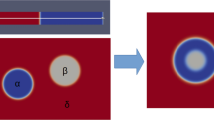Abstract
Formation of 1D Liesegang patterns was studied numerically in precipitation and reversible complex formation of precipitate scenarios in an electric field. The Ostwald’s supersaturation model reported by Buki, Kárpáti-Smidróczki and Zrínyi (BKZ model) was extended further. In the presence of an electric field the position of the first and the last bands (X n) measured from the junction point of the outer and the inner electrolytes can be described by the functionX n =a 1τ 1/2n +a 2τn +a 3, where τn is the time elapsed until the nth band formation,a 1,a 2 anda 3 are constants. The variation of the total number of bands with different electric field strengths (ε) has a maximum. For higher ε one can observe a moving precipitation zone that becomes wider due to precipitation and reversible complex formation.
Similar content being viewed by others
References
R E Liesegang,Naturwiss. Wochenschr. 11, 353 (1896)
S C Müller and J Ross,J. Phys. Chem. A107, 7997 (2003)
H W Morse and G W Pierce,Proc. Am. Acad. Arts Sci. 38, 625 (1903)
C S Kuo, E L Cabarcos and R Bansil,Physica A239, 120 (1997)
V Holba and F Fusek,Collect. Czech. Chem. C65, 1438 (2000)
J M García-Ruiz, D Rondón, A García-Romero and F Otálora,J. Phys. Chem. 100, 8854 (1996)
J George and G Varghese,Chem. Phys. Lett. 362, 8 (2002)
J George, I Paul, P A Varughese and G Varghese,Pramana — J. Phys. 60, 1259 (2003)
A Toramaru, T Harada and T Okamura,Physica D183, 133 (2003)
P Hantz,J. Phys. Chem. B104, 4266 (2000)
P Hantz,Phys. Chem. Chem. Phys. 4, 1262 (2002)
P Hantz,J. Chem. Phys. 117, 6646 (2002)
J Samseth, M B Kirkedelen, F A Maao, A Hansen and M-A Einarsrud,J. Non-Cryst. Solids 225, 298 (1998)
A H Sharbaugh III and A H Sharbaugh,J. Chem. Edu. 66, 589 (1989)
I Das, A Pushkarna and A Bhattacharjee,J. Phys. Chem. 94, 8968 (1990)
I Das, A Pushkarna and A Bhattacharjee,J. Phys. Chem. 95, 3866 (1991)
R Sultan and S Panjarian,Physica D157, 241 (2001)
R Sultan and R Halabieh,Chem. Phys. Lett. 332, 331 (2000)
R F Sultan,Phys. Chem. Chem. Phys. 4, 1253 (2002)
I Lagzi,Phys. Chem. Chem. Phys. 4,1268 (2002)
I Lagzi and F Izsák,Phys. Chem. Chem. Phys. 5, 4144 (2003)
M Al-Ghoul and R Sultan,J. Phys. Chem. A107, 1095 (2003)
R Sultan and S Sadek,J. Phys. Chem. 100, 16912 (1996)
V Nasreddine and R Sultan,J. Phys. Chem. A103, 2934 (1999)
Z Shreif, M Al-Ghoul and R Sultan,Chem. Phys. Chem. 3, 592 (2002)
M Zrínyi, L Gálfi, É Smidróczki, Z Rácz and F Horkay,J. Phys. Chem. 95, 1618 (1991)
N Hilal and R Sultan,Chem. Phys. Lett. 374, 183 (2003)
I Das, A Pushkarna and N R Agrawal,J. Phys. Chem. 93, 7269 (1989)
A Büki, É Kárpáti-Smidróczki, M Zrínyi,J. Chem. Phys. 103, 10387 (1995)
A Büki, É Kárpáti-Smidróczki and M Zrínyi,Physica A220, 357 (1995)
Author information
Authors and Affiliations
Rights and permissions
About this article
Cite this article
Lagzi, I. Liesegang patterns: Complex formation of precipitate in an electric field. Pramana - J Phys 64, 291–298 (2005). https://doi.org/10.1007/BF02704882
Received:
Revised:
Accepted:
Issue Date:
DOI: https://doi.org/10.1007/BF02704882




